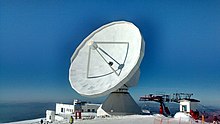astro.wikisort.org - Institution
The IRAM 30-meter telescope is a radio telescope used for astronomical observations in the millimeter range of wavelengths, operated by the Institute for Radio Astronomy in the Millimeter Range (IRAM) and located in the Sierra Nevada, Spain, close to the Pico Veleta peak. The 30-meter telescope is the most sensitive singular radio telescope in the world. Its large surface and wide-angle camera make it a perfect tool for the exploration of large cosmic objects such as interstellar clouds, birthplaces for stars, and even galaxies. The 30-meter telescope also allows astronomers to access parts of the southern skies and therefore to observe the black hole at the center of our galaxy.
This article's tone or style may not reflect the encyclopedic tone used on Wikipedia. (January 2022) |
 | |
| Alternative names | Pico Veleta observatory |
|---|---|
| Part of | Event Horizon Telescope |
| Location(s) | Veleta, Dílar, Monachil, Spain |
| Coordinates | 37°03′58″N 3°23′34″W |
| Organization | Institut de radioastronomie millimétrique |
| Altitude | 2,850 m (9,350 ft) |
| Wavelength | 0.8 mm (370 GHz)–3 mm (100 GHz) |
| Telescope style | radio telescope |
| Diameter | 30 m (98 ft 5 in) |
| Mounting | altazimuth mount |
| Website | www |
 Location of IRAM 30m telescope | |
| | |
Each year, more than 200 scientists from all over the world visit this observatory to explore the universe at millimeter wavelengths, with interests going from the Solar System to interstellar dust and gas or cosmology. Together with IRAM's second facility, the NOEMA observatory, the 30-meter telescope is part of the global Event Horizon Telescope array. It was the only station in Europe to participate in the 2017 EHT observing campaign that produced the first-ever image of a black hole.[1]
Operation
Built-in four years (1980-1984),[2][3] the telescope operates at 2850 meters above sea level. Due to its large surface, the 30-meter telescope is highly sensitive and well-adapted to detect weak sources. The surface of the parabola with its 420 panels is adjusted to a precision of 55 micrometers, corresponding to the width of a human hair.
The telescope is equipped with a suite of heterodyne receivers and continuum cameras operating at wavelengths of around 0.8, 1, 2, and 3 millimeters. By pointing the telescope toward a celestial source, and then scanning and tracking the source, astronomers can build up radio images – of complete galaxies or regions of star formation in the Milky Way. With its ability to observe simultaneously at several wavelengths, the telescope can produce multiple images of the same region at once.
IRAM offers guided tours through the observatory and public talks during the summer months.
Science
Compared to optical astronomy, which is sensitive to the hot universe (stars are generally a few thousand degrees Celsius), radio telescopes that operate in the millimeter wavebands, such as the IRAM 30-meter telescope, can view the cold universe (around −250°C). Both IRAM facilities can see the formation of the first galaxies in the universe, observe super-giant black holes at the center of galaxies, analyze the chemical evolution and dynamics of nearby galaxies, detect organic molecules and possible key elements of life, and investigate the formation of stars and the appearance of planetary systems.[citation needed]
As part of the EHT array, the IRAM 30-meter telescope obtained the first-ever image of a black hole. But EHT is not the only area in which the IRAM has done pioneering work. For instance, the first high-resolution radio observations of the heart of the Milky Way galaxy and its black hole named Sagittarius A* were made in 1995 – with a combination of the IRAM 30-meter telescope and the NOEMA array (former Plateau de Bure Interferometer). The telescope also obtained the first complete and detailed radio images of nearby galaxies and their gases.[4][5][6][7] Together with NOEMA, it discovered one-third of the interstellar molecules known to date (published ApJ, 2018, Brett A. McGuire[8]).
Gallery
- The IRAM 30-meter telescope scanning the night sky
- The IRAM 30-meter telescope
- The NOEMA observatory, IRAM's second facility
References
- "Event Horizon Telescope Captures First Image of Black Hole | Astronomy | Sci-News.com". Breaking Science News | Sci-News.com. Retrieved 2019-04-10.
- Baars, Hooghoudt, Mezger, & de Jonge (1987). "The IRAM 30-m millimeter radio telescope on Pico Veleta, Spain". Astronomy & Astrophysics. 175: 319–326.
{{cite journal}}: CS1 maint: multiple names: authors list (link) - Encrenaz, Gómez-González, Lequeux, and Orchiston (2011). "HIGHLIGHTING THE HISTORY OF FRENCH RADIO ASTRONOMY. 7: THE GENESIS OF THE INSTITUTE OF RADIOASTRONOMY AT MILLIMETER WAVELENGTHS (IRAM)". Journal of Astronomical History and Heritage. 14 (2): 83–92.
{{cite journal}}: CS1 maint: multiple names: authors list (link) - "publications". www2.mpia-hd.mpg.de. Retrieved 2021-01-12.
- "PAWS". www.iram-institute.org. Retrieved 2021-01-12.
- "Cloud atlas reshapes astronomers' views of stellar birthplaces". www.iram-institute.org. Retrieved 2021-01-12.
- https://web-archives.iram.fr/IRAMFR/ARN/AnnualReports/IRAM_2006.pdf [bare URL PDF]
- McGuire, Brett A. (2018). "2018 Census of Interstellar, Circumstellar, Extragalactic, Protoplanetary Disk, and Exoplanetary Molecules". The Astrophysical Journal Supplement Series. 239 (2): 17. doi:10.3847/1538-4365/aae5d2. S2CID 119522774.
На других языках
- [en] IRAM 30m telescope
[es] Observatorio IRAM Pico Veleta
El Observatorio IRAM Pico Veleta o IRAM 30m es un radiotelescopio perteneciente al Instituto de Radioastronomía Milimétrica que está situado en la loma de Dilar en Sierra Nevada a una altura de 2850 msnm.Другой контент может иметь иную лицензию. Перед использованием материалов сайта WikiSort.org внимательно изучите правила лицензирования конкретных элементов наполнения сайта.
WikiSort.org - проект по пересортировке и дополнению контента Википедии


